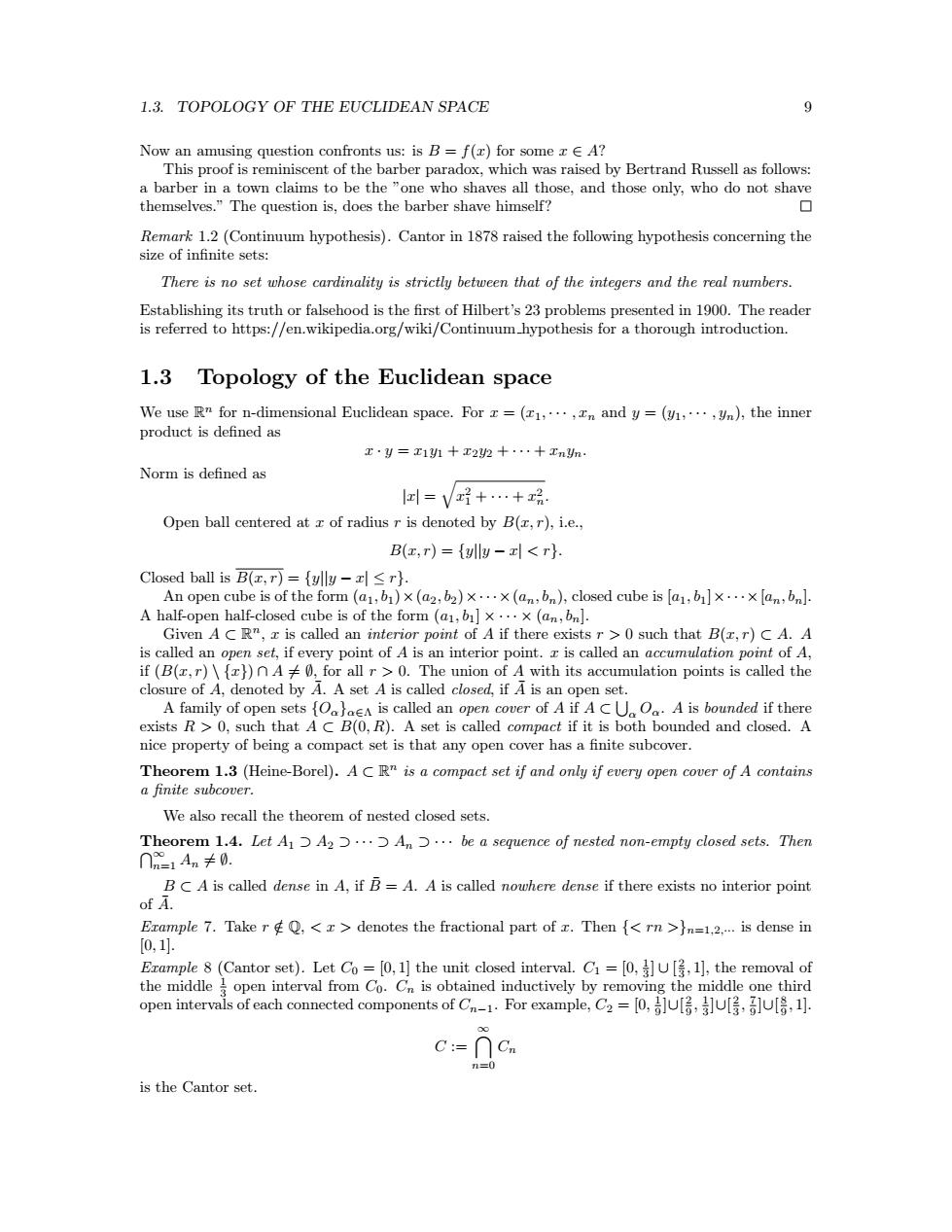正在加载图片...

1.3.TOPOLOGY OF THE EUCLIDEAN SPACE Now an is B=f(r)for mex∈A? This of the barber paradox which was raised by Bertrand Russellas There is no set whose cardinality is strictly between that of the integers and the real numbers. ipedia. 1.3 Topology of the Euclidean space We use Ra for n-dimensional Euclidean space.For =(1..andy=(.),the inner product is defined as 工·y=r1边+r22+··+xmn Norm is defined as 回=√+…+ Open ball centered at r of radius r is denoted by B(.r).i.e., B(z.r)=uy-<r). Closed ball is B(r)=fly-). ope a))cod eabe s open ha ce is of the form is called an set if ove int of A is an interio if ()for.The uion of ts acculation points is called the denoted by A set A is called closed,if A is an n se existsR> nice property of being a compact setis that any open cover hasa finite subcover. Theneml3但eineBare.AcRrwaompdtfamdomtfeenyopeacorgofAcontains We also recall the theorem of nested closed sets. Theorem 1.4.Let AAA..be a sequence of nested non-emply closed sets.Then ∩e1A≠0. nle 8 (Cantor set).Let co =o 11 the unit closed int moval of the middle ne third open intervals of each connected components of Cn-1.For example,C2=0,1]. c=∩c. is the Cantor set. 1.3. TOPOLOGY OF THE EUCLIDEAN SPACE 9 Now an amusing question confronts us: is B = f(x) for some x ∈ A? This proof is reminiscent of the barber paradox, which was raised by Bertrand Russell as follows: a barber in a town claims to be the ”one who shaves all those, and those only, who do not shave themselves.” The question is, does the barber shave himself? Remark 1.2 (Continuum hypothesis). Cantor in 1878 raised the following hypothesis concerning the size of infinite sets: There is no set whose cardinality is strictly between that of the integers and the real numbers. Establishing its truth or falsehood is the first of Hilbert’s 23 problems presented in 1900. The reader is referred to https://en.wikipedia.org/wiki/Continuum hypothesis for a thorough introduction. 1.3 Topology of the Euclidean space We use R n for n-dimensional Euclidean space. For x = (x1, · · · , xn and y = (y1, · · · , yn), the inner product is defined as x · y = x1y1 + x2y2 + · · · + xnyn. Norm is defined as |x| = q x 2 1 + · · · + x 2 n . Open ball centered at x of radius r is denoted by B(x, r), i.e., B(x, r) = {y||y − x| < r}. Closed ball is B(x, r) = {y||y − x| ≤ r}. An open cube is of the form (a1, b1)×(a2, b2)×· · ·×(an, bn), closed cube is [a1, b1]×· · ·×[an, bn]. A half-open half-closed cube is of the form (a1, b1] × · · · × (an, bn]. Given A ⊂ R n, x is called an interior point of A if there exists r > 0 such that B(x, r) ⊂ A. A is called an open set, if every point of A is an interior point. x is called an accumulation point of A, if (B(x, r) \ {x}) ∩ A 6= ∅, for all r > 0. The union of A with its accumulation points is called the closure of A, denoted by A¯. A set A is called closed, if A¯ is an open set. A family of open sets {Oα}α∈Λ is called an open cover of A if A ⊂ S α Oα. A is bounded if there exists R > 0, such that A ⊂ B(0, R). A set is called compact if it is both bounded and closed. A nice property of being a compact set is that any open cover has a finite subcover. Theorem 1.3 (Heine-Borel). A ⊂ R n is a compact set if and only if every open cover of A contains a finite subcover. We also recall the theorem of nested closed sets. Theorem 1.4. Let A1 ⊃ A2 ⊃ · · · ⊃ An ⊃ · · · be a sequence of nested non-empty closed sets. Then T∞ n=1 An 6= ∅. B ⊂ A is called dense in A, if B¯ = A. A is called nowhere dense if there exists no interior point of A¯. Example 7. Take r /∈ Q, < x > denotes the fractional part of x. Then {< rn >}n=1,2,··· is dense in [0, 1]. Example 8 (Cantor set). Let C0 = [0, 1] the unit closed interval. C1 = [0, 1 3 ] ∪ [ 2 3 , 1], the removal of the middle 1 3 open interval from C0. Cn is obtained inductively by removing the middle one third open intervals of each connected components of Cn−1. For example, C2 = [0, 1 9 ]∪[ 2 9 , 1 3 ]∪[ 2 3 , 7 9 ]∪[ 8 9 , 1]. C := \∞ n=0 Cn is the Cantor set